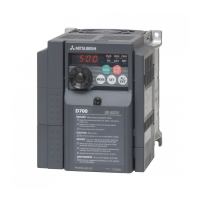What to do if Mitsubishi Electric Inverter motor will not start?
- CCourtney CooleyAug 13, 2025
If the motor connected to your Mitsubishi Electric Inverter won't start, consider the following checks: Examine the Pr. 0 Torque boost setting if V/F control is exercised, inspect the main circuit, check the input signals, verify the parameter settings, perform a load inspection, and consider other potential issues.








